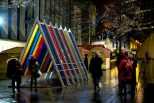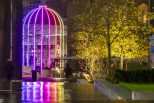"Forest of Light" installation that explores the idea of interaction and perspective; the darkened space is lit by towering…

“You are what you eat”. Starting with this old saying, the Pavilion of the Republic of Korea guides the visitor to the discovery of ancient food traditions. The outer architecture of the pavilion, one of the largest of Expo, evokes the shape of the “Moon Jar”, a traditional Korean white porcelain vase that symbolizes the full moon. This led to the exclusive use of the white colour, which includes a long strip of spotlights (Rio by Fosnova) with the goal to design a luminous path accompanying visitors to the restaurant area at the entrance of the pavilion.

Once inside the pavilion, visitors can learn, through a series of installations and spectacular videos, about Korean eating traditions, including the Hansik, a traditional technique to preserve foods based on fermentation. In the traditional vase, reproduced in large scale inside the pavilion, soy-based sauces are left to ferment and become the secret ingredient of so many Korean dishes.
This ancient know-how will be proposed as a possible approach to our planet’s food issue, which range from undernourishment to obesity. Korean cuisine is full of vegetables and fish, perfectly in line with the recommendations of nutritionists.
The shape of another traditional container, the onggi, is used for an installation that includes hundreds of small lighting screens. The spectacle of lights and sound reproduces the succession of the seasons to illustrate what happens to food with natural preservation techniques. The pavilion is one of the most popular ones in Expo for its educational content. In addition to clear explanations on the Korean fermentation techniques, a series of images illustrates the great variety of dishes that can be obtained with these techniques and how they can promote good eating habits to ensure a healthy and long life





